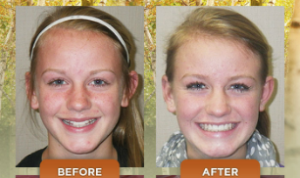1. What Is Early Treatment?
Early treatment involves the use of orthodontic appliances, or partial braces, to guide the growth of developing jaw bones and create a better environment for the adult teeth as they emerge.
In most cases, this early phase of treatment is followed by comprehensive orthodontic treatment (full braces) at the appropriate age. This second phase of treatment is usually shorter, less involved, and more effective due to the earlier treatment. This is usually referred to as “two phase” orthodontic therapy.
In most of these cases, we can achieve results that wouldn’t be possible once the face and jaws have finished growing. Early treatment gives us the chance to:
• Guide jaw growth • Lower the risk of trauma to protruded front teeth
• Improve appearance and self-esteem • Guide permanent teeth into a better position
• Improve the way lips meet
• Correct harmful habits like thumb sucking, tongue thrusting, lip wedging.
In our practice, we find that approximately 40 percent of our patients can benefit from some form of early treatment. Early treatment prevents more serious problems from developing and makes treatment at a later age shorter and less complicated.
The majority of our early patient visits result in observation only – at no cost to the parent.
When indicated, early treatment will improve your child’s smile at a young age, boosting their self-esteem. It will also improve the stability of our final orthodontic result. That is a fact.
2. The American Association of Orthodontists Recommendation:
The American Association of Orthodontists recommends that all children should have an orthodontic evaluation by age 7. An experienced orthodontist can clearly see by age seven whether developmental issues can turn into problems. Early detection of common orthodontic problems such as crowding, premature loss of baby teeth, cross bites, or many other unfavorable developmental issues can lead to the implementation of the most appropriate treatment, that can result in a shorter course of therapy. The final result will be more stable, and in most cases the need for permanent tooth extractions can be eliminated.
Frequently, no early intervention will be necessary, except careful monitoring of your child’s dental development. This will give you peace of mind when it is not clear to you whether an issue you see is really a problem or just a stage of development that doesn’t require intervention.
3. What are the Indications for early treatment?
The patient would benefit from early treatment if any of the following are present:
• Early or late loss of permanent teeth • Difficulty in chewing
• Breathing through the mouth • Thumb sucking
• Crowded, misplaced or blocked-out teeth • Jaws that are too far forward or back
• Biting the cheeks or into the roof of the mouth
• Front teeth that do not meet, or meet in an abnormal way
• An unbalanced facial appearance • Grinding or clenching of the teeth
4. Why Didn’t My Dentist Mention That?
The art and science of Orthodontics involves years (after Dental school) of specialized orthodontic training.
At Horner Barrow Orthodontics our doctors make many of their decisions regarding the appropriate care, based on expertise they have acquired after having successfully completed treatment on thousands of patients.
Most family dentists are very busy taking care of teeth and gum issues that affect the health of the mouth. They are not trained to spot early orthodontic problems which, if left untreated, complicate the future orthodontic correction.
It is best that a qualified Orthodontic specialist be the one to make the decision about when to start your child’s orthodontic treatment.
To seek treatment at our office, you do not need to be referred by your general dentist.
5. How do I have my child evaluated by the doctors at Horner Barrow Orthodontics?
The first step is to call our office to set up a free initial screening. This can also be scheduled on our website.
This screening appointment usually takes 15-30 minutes. Our goal is to provide you with the following information:
• We will identify your child’s orthodontic problems.
• We can pinpoint the best time to start treatment.
• We can estimate the duration of treatment.
• We can demonstrate the types of appliances that will be necessary.
• We can discuss the cost, and payment options.
Sometimes, the Doctor will suggest taking photos and a panoramic x-ray in order to provide you with all of this information.
 1. See your dentist regularly. Every 3 to 4 months while in braces. Your teeth are not as clean as they were the day you got your braces. Even if you brush and floss regularly, you must see your dentist regularly.
1. See your dentist regularly. Every 3 to 4 months while in braces. Your teeth are not as clean as they were the day you got your braces. Even if you brush and floss regularly, you must see your dentist regularly.
